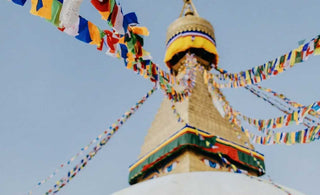
Nepal, a land steeped in spirituality, unfolds a tapestry of traditions that echo through its picturesque landscapes. Among these, the prayer flag tradition stands tall, literally. The Darchog style, where prayer flags hang vertically on poles, encapsulates a unique and symbolic approach to conveying aspirations and blessings. In this exploration, we delve into six facets that illuminate the distinctiveness and profound meanings embedded in the vertical hanging of Nepal prayer flags.
1. Vertical Alignment: A Symbolic Axis
The choice to hang prayer flags vertically creates a powerful symbolic axis, linking the earthly realm to the heavens above. Unlike the diagonal arrangement, the vertical alignment draws a direct line from the ground to the sky, symbolizing a seamless connection between the terrestrial and celestial dimensions. This verticality is laden with spiritual significance, suggesting a direct conduit for prayers to ascend unimpeded.
These poles, often crafted from wood or bamboo, transcend their physical form to become symbolic anchors in the spiritual landscape. They represent stability, endurance, and the unyielding nature of faith. As prayer flags drape themselves over these wooden sentinels, the poles become conduits for the earthly prayers seeking divine attention.
2. Suspended Intentions: Elevating Aspirations
As the prayer flags hang vertically, they become vessels for elevated aspirations. The act of suspending these colorful banners is not merely a physical gesture but a profound elevation of intentions. Each flag becomes a carrier of hopes, dreams, and prayers, ascending vertically into the realm of the divine. The vertical hanging style transforms the flags into tangible manifestations of collective yearnings reaching towards the heavens.
3. Harmony in Heights: Balancing the Elements
In the vertical arrangement, the prayer flags sway in harmony with the wind, creating a dance that mirrors the balance of elements. The flags, with their distinctive colors representing earth, water, fire, air, and space, harmonize as they flutter vertically. This dance reflects the equilibrium sought in the natural world and embodies the belief that such balance can bring about spiritual harmony and well-being.
The vertical alignment of prayer flags on poles imparts a sense of intentionality to the ritual. Unlike the random fluttering of flags in the wind, the deliberate arrangement on poles directs the flow of spiritual currents. Each flag, hanging in a vertical sequence, becomes a participant in a sacred choreography—a dance choreographed by the hands of believers and the whispers of the divine. The poles serve as guardians, directing the energy of prayers upward with focused intent.
4. Pillars of Devotion: Significance of Poles
The vertical hanging style introduces the element of poles, transforming the act of hanging prayer flags into a ritual with deeper layers of meaning. The poles symbolize stability and strength, serving as pillars that uphold the collective aspirations of the community. These poles are not merely physical supports but become metaphysical conduits, grounding the spiritual energies while reaching towards celestial heights.
5. Directional Energy Flow: Channeling Spiritual Forces
In the vertical alignment, the flow of energy takes on a directional focus. The flags, as they hang from poles, channel spiritual forces in a deliberate manner. This focused flow aligns with the intentionality of prayers, guiding the energy upwards with purpose. The vertical arrangement is akin to an energetic pathway, directing the collective consciousness of a community towards a shared spiritual destination.
Beyond their role as physical supports, the poles act as temporal bridges, connecting the past, present, and future. Through generations, these wooden sentinels witness the ebb and flow of prayers, carrying the legacy of a community's devotion. As new flags are added and old ones weather with time, the poles become repositories of spiritual history, linking the continuum of prayers across time. The vertical alignment, therefore, becomes a visual representation of a timeless spiritual journey.
6. Temporal Symmetry: A Continuum of Blessings
Unlike diagonal arrangements that may be subject to the ephemeral nature of wind patterns, the vertical hanging style offers a sense of temporal symmetry. The flags, aligned in a vertical continuum, present a timeless visual that echoes the enduring nature of blessings. The verticality suggests a perpetual flow of prayers, creating a spiritual timeline that transcends the immediate present.
Through the vertical hanging of prayer flags on poles, mundane acts become infused with sacred significance. The simple act of raising a flag becomes a ritualistic offering, a communion between the earthly and the divine. The poles, standing tall and resolute, empower believers to elevate their daily intentions, transforming routine actions into profound spiritual expressions. In this way, the vertical hanging style transforms the ordinary into the extraordinary, turning the act of hanging flags into a sacred ceremony.
Conclusion: Eternal Reverberations
In the Darchog style, where prayer flags adorn poles and hang vertically, we witness not just a physical display but a profound manifestation of spiritual depth. The vertical alignment becomes a sacred axis, a pathway where earthly aspirations ascend towards celestial realms. As the flags sway in harmony with the wind, suspended between the earthly poles and the celestial heights, they create a visual symphony that resonates with the eternal reverberations of Nepal's rich spiritual heritage. Each flag becomes a testament to the enduring connection between the people, the land, and the divine—a connection that echoes through time, carried by the winds of devotion and faith. In this unique style of hanging, the prayer flags stand not just as colorful symbols but as pillars of a transcendent bridge that spans the realms of the seen and the unseen, the temporal and the eternal.























